α-Glucosidase and Bacterial β-Glucuronidase Inhibitors from the Stems of Schisandra sphaerandra Staph
Abstract
:1. Introduction
2. Results and Discussion
2.1. Structure Elucidation
2.2. AGS and BGUS Inhibitory Activity
2.3. Analysis of Inhibition Kinetics
2.4. Molecular Docking Studies
3. Materials and Methods
3.1. General Experimental Procedure
3.2. Plant Material
3.3. Extraction and Isolation
3.4. Single-Crystal X-ray Diffraction
3.5. AGS and BGUS Inhibitory Assays
3.6. Inhibition Kinetics Analysis
3.7. Molecular Docking Simulation
4. Conclusions
Supplementary Materials
Author Contributions
Funding
Institutional Review Board Statement
Informed Consent Statement
Data Availability Statement
Conflicts of Interest
References
- Ogurtsova, K.; da Rocha Fernandes, J.D.; Huang, Y.; Linnenkamp, U.; Guariguata, L.; Cho, N.H.; Cavan, D.; Shaw, J.E.; Makaroff, L.E. DF Diabetes Atlas: Global estimates for the prevalence of diabetes for 2015 and 2040. Diabetes Res. Clin. Pract. 2017, 128, 40–50. [Google Scholar] [CrossRef] [PubMed] [Green Version]
- International Diabetes Federation. What Is Diabetes. In IDF Diabetes Atlas, 6th ed.; International Diabetes Federation: Brussels, Belgium, 2013; pp. 19–27. [Google Scholar]
- Santos, C.M.M.; Freitas, M.; Fernandes, E. A Comprehensive Review on Xanthone Derivatives as α-Glucosidase Inhibitors. Eur. J. Med. Chem. 2018, 157, 1460–1479. [Google Scholar] [CrossRef] [PubMed]
- Krentz, A.J.; Bailey, C.J. Oral Antidiabetic Agents: Current Role in Type 2 Diabetes Mellitus. Drugs 2005, 65, 385–411. [Google Scholar] [CrossRef] [PubMed]
- Zheng, Y.; Ley, S.H.; Hu, F.B. Global Aetiology and Epidemiology of Type 2 Diabetes Mellitus and Its Complications. Nat. Rev. Endocrinol. 2018, 14, 88–98. [Google Scholar] [CrossRef]
- Bellucci, P.N.; Gonzalez Bagnes, M.F.; Di Girolamo, G.; Gonzalez, C.D. Potential Effects of Nonsteroidal Anti-Inflammatory Drugs in the Prevention and Treatment of Type 2 Diabetes Mellitus. J. Pharm. Pract. 2016, 30, 549–556. [Google Scholar] [CrossRef]
- Donath, M.Y.; Shoelson, S.E. Type 2 diabetes as an inflammatory disease. Nat. Rev. Immunol. 2011, 11, 98–107. [Google Scholar] [CrossRef]
- Weiderpass, E.; Gridley, G.; Nyrén, O.; Ekbom, A.; Persson, I.; Adami, H.O. Diabetes Mellitus and Risk of Large Bowel Cancer. J. Nat. Cancer Inst. 1997, 89, 660–661. [Google Scholar] [CrossRef]
- Ohkuma, T.; Peters, S.A.E.; Woodward, M. Sex Differences in the Association between Diabetes and Cancer: A Systematic Review and Meta-analysis of 121 Cohorts Including 20 million Individuals and One Million Events. Diabetologia 2018, 61, 2140–2154. [Google Scholar] [CrossRef] [Green Version]
- Nicolucci, A. Epidemiological Aspects of Neoplasms in Diabetes. Acta Diabetol. 2010, 47, 87–95. [Google Scholar] [CrossRef]
- Hu, F.B.; Manson, J.E.; Liu, S.; Hunter, D.; Colditz, G.A.; Michels, K.B.; Speizer, F.E.; Giovannucci, E. Prospective Study of Adult Onset Diabetes Mellitus (Type 2) and Risk of Colorectal Cancer in Women. J. Natl. Cancer Inst. 1999, 91, 542–547. [Google Scholar] [CrossRef]
- KMills, T.; Bellows, C.F.; Hoffman, A.E.; Kelly, T.N.; Gagliardi, G. Diabetes Mellitus and Colorectal Cancer Prognosis: A Meta-analysis, Dis. Colon Rectum 2013, 56, 1304–1319. [Google Scholar] [CrossRef] [PubMed] [Green Version]
- Sun, R.J.; Zhu, L.J.; Li, L.; Song, W.J.; Gong, X.; Qi, X.X.; Wang, Y.; Ghose, R.; Gao, S.; Hu, M.; et al. Irinotecan-mediated Diarrhea Is Mainly Correlated with Intestinal Exposure to SN-38: Critical Role of Gut Ugt. Toxicol. Appl. Pharmacol. 2020, 398, 115032. [Google Scholar] [CrossRef] [PubMed]
- Wallace, B.D.; Wang, H.; Lane, K.T.; Scott, J.E.; Orans, J.; Koo, J.S.; Venkatesh, M.; Jobin, C.; Yeh, L.A.; Mani, S.; et al. Alleviating Cancer Drug Toxicity by Inhibiting a Bacterial Enzyme. Science 2010, 330, 831–835. [Google Scholar] [CrossRef] [PubMed] [Green Version]
- Chamseddine, A.N.; Ducreux, M.; Armand, J.P.; Paoletti, X.; Satar, T.; Paci, A.; Mir, O. Intestinal Bacterial Beta-glucuronidase as a Possible Predictive Biomarker of Irinotecan-induced Diarrhea Severity. Pharmacol. Ther. 2019, 199, 1–15. [Google Scholar] [CrossRef]
- Chinese Pharmacopoeia Commission. Pharmacopoeia of the People’s Republic of China; China Chemical Industry Press: Beijing, China, 2005.
- Chang, J.; Reiner, J.; Xie, J. Progress on the Chemistry of Dibenzocyclooctadiene Lignans. Chem. Rev. 2005, 105, 4581–4609. [Google Scholar] [CrossRef]
- Xiao, W.L.; Li, R.T.; Huang, S.X.; Pu, J.X.; Sun, H.D. Triterpenoids from the Schisandraceae Family. Nat. Prod. Rep. 2008, 25, 871–891. [Google Scholar] [CrossRef]
- Shi, Y.M.; Xiao, W.L.; Pu, J.X.; Sun, H.D. Triterpenoids from the Schisandraceae Family: An Update. Nat. Prod. Rep. 2015, 32, 367–410. [Google Scholar] [CrossRef]
- Sun, H.D.; Qiu, S.X.; Lin, L.Z.; Wang, Z.Y.; Lin, Z.W.; Pengsuparp, T.; Pezzuto, J.M.; Fong, H.H.S.; Cordell, G.A.; Farnsworth, N.R. Nigranoic Acid, a Triterpenoid from Schisandra sphaerandra that Inhibits HIV-1 Reverse Transcriptase. J. Nat. Prod. 1996, 59, 525–527. [Google Scholar] [CrossRef]
- Guo, J.; Liu, L.H.; Mei, S.X.; Zhao, J.F.; Ma, Z.R.; Li, L. Studies on Chemical Constituents from the Stems of Schisandra sphaerandra. Chin. J. Chin. Mater. Med. 2003, 28, 138–140. [Google Scholar]
- Hu, K.; Li, X.R.; Tang, J.W.; Li, X.N.; Puno, P.T. Structural determination of eleven new preschisanartane-type schinortriterpenoids from two Schisandra species and structural revision of preschisanartanin J using NMR computation method. Chin. J. Nat. Med. 2019, 17, 970–981. [Google Scholar] [CrossRef]
- Ying, Y.M.; Yu, H.F.; Tong, C.P.; Shan, W.G.; Zhan, Z.J. Spiroinonotsuoxotriols A and B, Two Highly Rearranged Triterpenoids from Inonotus obliquus. Org. Lett. 2020, 22, 3377–3380. [Google Scholar] [CrossRef] [PubMed]
- Ma, L.F.; Yan, J.J.; Lane, H.Y.; Jin, L.C.; Qiu, F.J.; Wang, Y.J.; Xi, Z.F.; Shan, W.G.; Zhan, Z.J.; Ying, Y.M. Bioassay-guided Isolation of Lanostane-type Triterpenoids as Alpha-glucosidase Inhibitors from Ganoderma hainanense. Phytochem. Lett. 2019, 29, 154–159. [Google Scholar] [CrossRef]
- Ying, Y.M.; Fang, C.A.; Yao, J.Y.; Yu, Y.; Shen, Y.; Hou, Z.N.; Wang, Z.; Zhang, W.; Shan, W.G.; Zhan, Z.J. Bergamotane Sesquiterpenes with Alpha-Glucosidase Inhibitory Activity from the Plant Pathogenic Fungus Penicillium expansum. Chem. Biodivers. 2017, 14, e1600184. [Google Scholar] [CrossRef] [PubMed]
- Ying, Y.M.; Zhang, L.Y.; Zhang, X.; Bai, H.B.; Liang, D.E.; Ma, L.F.; Shan, W.G.; Zhan, Z.J. Terpenoids with Alpha-glucosidase Inhibitory Activity from the Submerged Culture of Inonotus obliquus. Phytochemistry 2014, 108, 171–176. [Google Scholar] [CrossRef]
- Yu, H.F.; Cheng, Y.C.; Wu, C.M.; Ran, K.; Wei, B.; Xu, Y.K.; Shan, W.G.; Ying, Y.M. Diverse diterpenoids with α-glucosidase and β-glucuronidase inhibitory activities from Euphorbia milii. Phytochemistry 2022, 196, 113106. [Google Scholar] [CrossRef]
- Ying, Y.M.; Yu, H.F.; Rao, G.W.; Wang, J.W.; Shan, W.G.; Zhan, Z.J. Dibenzocyclooctadiene Lignans from the Stems of Schisandra sphaerandra. Nat. Prod. Res. 2020, 36, 287–294. [Google Scholar] [CrossRef]
- Wang, W.; Liu, J.Z.; Han, J.; Xu, Z.R.; Liu, R.X.; Liu, P.; Wang, W.X.; Ma, X.C.; Guan, S.H.; Guo, D.A. New Triterpenoids from Kadsura heteroclita and Their Cytotoxic Activity. Planta Med. 2006, 72, 450–457. [Google Scholar] [CrossRef]
- Xue, Y.B.; Yang, J.H.; Li, X.N.; Du, X.; Pu, J.X.; Xiao, W.L.; Su, J.; Zhao, W.; Li, Y.; Sun, H.D. Henrischinins A-C: Three New Triterpenoids from Schisandra henryi. Org. Lett. 2011, 13, 1564–1567. [Google Scholar] [CrossRef]
- Liu, J.S.; Huang, M.F.; Ayer, W.A.; Bigam, G. Schisanlactone B, a New Triterpenoid from a Schisandra sp. Tetrahedron Lett. 1983, 24, 2355–2358. [Google Scholar] [CrossRef]
- Sy, L.K.; Saunders, R.M.K.; Brown, G.D. Phytochemistry of Illicium dunnianum and the Systematic Position of Illiciaceae. Phytochemistry 1997, 44, 1099–1108. [Google Scholar] [CrossRef]
- Zou, J.; Jiang, J.; Diao, Y.Y.; Yang, L.B.; Huang, J.; Li, H.L.; Du, X.; Xiao, W.L.; Pu, J.X.; Sun, H.D. Cycloartane Triterpenoids from the Stems of Schisandra glaucescens and Their Bioactivity. Fitoterapia 2012, 83, 926–931. [Google Scholar] [CrossRef] [PubMed]
- Li, R.T.; Han, Q.B.; Zhao, A.H.; Sun, H.D. Micranoic Acids A and B: Two New Octanortriterpenoids from Schisandra micrantha. Chem. Pharm. Bull. 2003, 51, 1174–1176. [Google Scholar] [CrossRef] [PubMed] [Green Version]
- Stoessl, A.; Stothers, J.B.; Ward, E.W.B. The Structures of some Stress Metabolites from Solanum melongena. Can. J. Chem. 2011, 53, 3351–3358. [Google Scholar] [CrossRef]
- Yang, X.L.; Zhang, S.; Song, S.J.; Zhang, Y.; Luo, D.Q.; Zhang, M. A New Biphenyl from the Fermentation Broth of Plant Endophytic Fungus Pestalotiopsis zonata isolated from Cyrtotachys lakka. Chin. J. Nat. Med. 2011, 9, 101–104. [Google Scholar] [CrossRef]
- Wang, W.; Liu, J.Z.; Yang, M.; Sun, J.H.; Wang, X.M.; Liu, R.X.; Guo, D.A. Simultaneous Determination of Six Major Constituents in the Stems of Kadsura heteroclita by LC-DAD. Chromatographia 2006, 64, 297–302. [Google Scholar] [CrossRef]
- Jia, Z.W.; Lu, Y.; Liao, Z.X.; Chen, D.F. Two New Triterpene Lactones from the Stems of Kadsura polysperma. Helv. Chim. Acta 2007, 90, 1236–1243. [Google Scholar] [CrossRef]
- Yu, H.H.; Zeng, R.; Lin, Y.; Li, X.; Tasneem, S.; Yang, Z.; Qiu, Y.X.; Li, B.; Wang, Y.H.; Cai, X.; et al. Kadsura heteroclita Stem Suppresses the Onset and Progression of Adjuvant-induced Arthritis in Rats. Phytomedicine 2019, 58, 152876. [Google Scholar] [CrossRef]
- Flores-Bocanegra, L.; González-Andrade, M.; Bye, R.; Linares, E.; Mata, R. α-Glucosidase Inhibitors from Salvia circinata. J. Nat. Prod. 2017, 80, 1584–1593. [Google Scholar] [CrossRef]
- Escandón-Rivera, S.; Pérez-Vásquez, A.; Navarrete, A.; Hernández, M.; Linares, E.; Bye, R.; Mata, R. Anti-Hyperglycemic Activity of Major Compounds from Calea ternifolia. Molecules 2017, 22, 289. [Google Scholar] [CrossRef] [Green Version]
- Laural, F.B.; Rafael, T.C.; Martin, G.A.; Jose, S.C.; Rachel, M. In Vivo and In Vitro α-Glucosidase Inhibitory Activity of Perfoliatin A from Melampodium perfoliatum. Nat. Prod. Commun. 2019, 14, 5–6. [Google Scholar] [CrossRef] [Green Version]
- Sheldrick, G.M. SHELXT-Integrated Space-group and Crystal-structure determination. Acta Cryst. A 2015, 71, 3–8. [Google Scholar] [CrossRef] [PubMed] [Green Version]
- Sheldrick, G.M. Crystal Structure Refinement with SHELXL. Acta Cryst. C 2015, 71, 3–8. [Google Scholar] [CrossRef] [PubMed]
- Dolomanov, O.V.; Bourhis, L.J.; Gildea, R.J.; Howard, J.A.K.; Puschmann, H.J. OLEX2: A complete structure solution, refinement and analysis program. Appl. Crystallogr. 2009, 42, 339–341. [Google Scholar] [CrossRef]
- Schwede, T.; Kopp, J.; Guex, N.; Peitsch, M.C. SWISS-MODEL: An automated protein homology-modeling server. Nucleic Acids Res. 2003, 31, 3381–3385. [Google Scholar] [CrossRef] [Green Version]
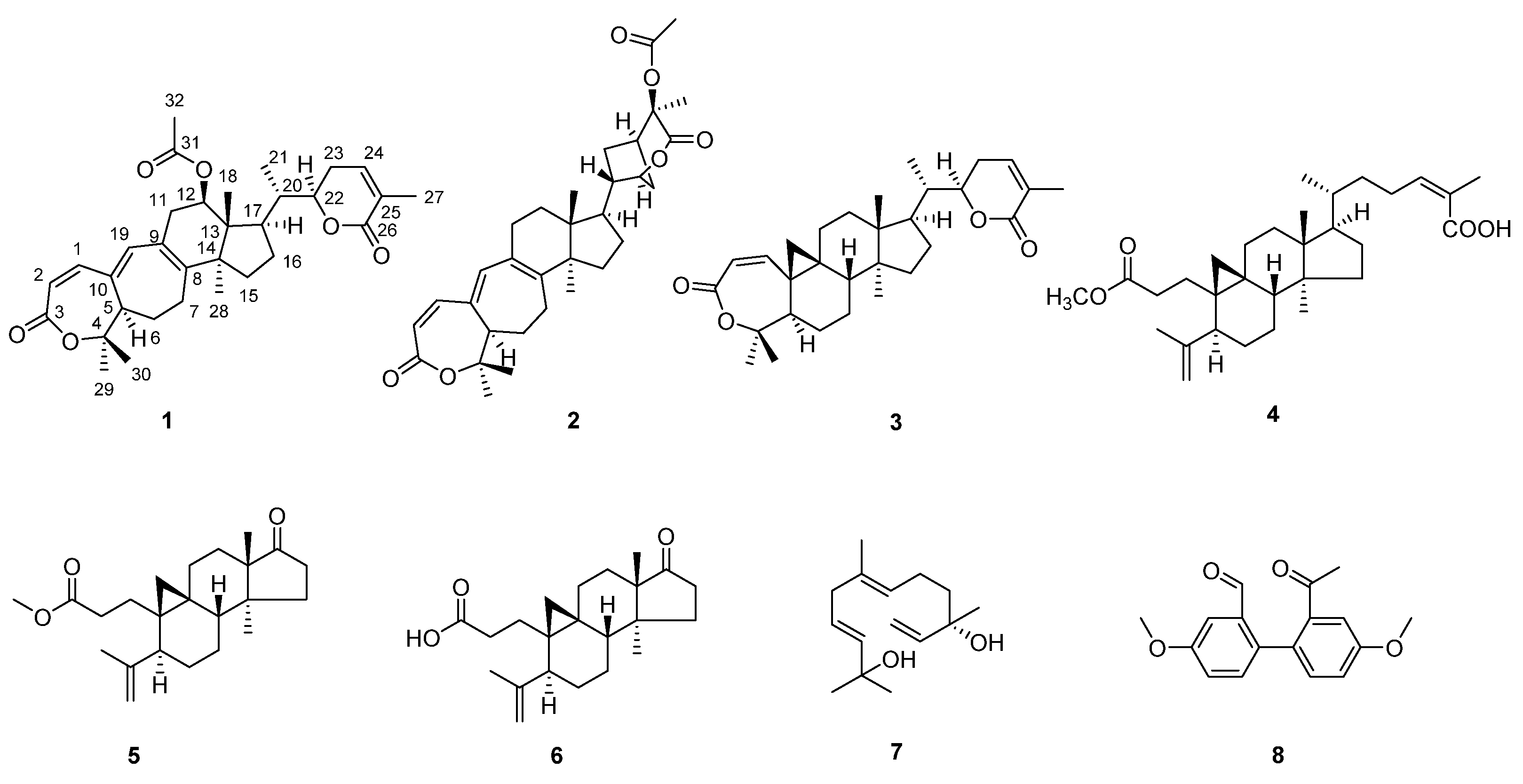

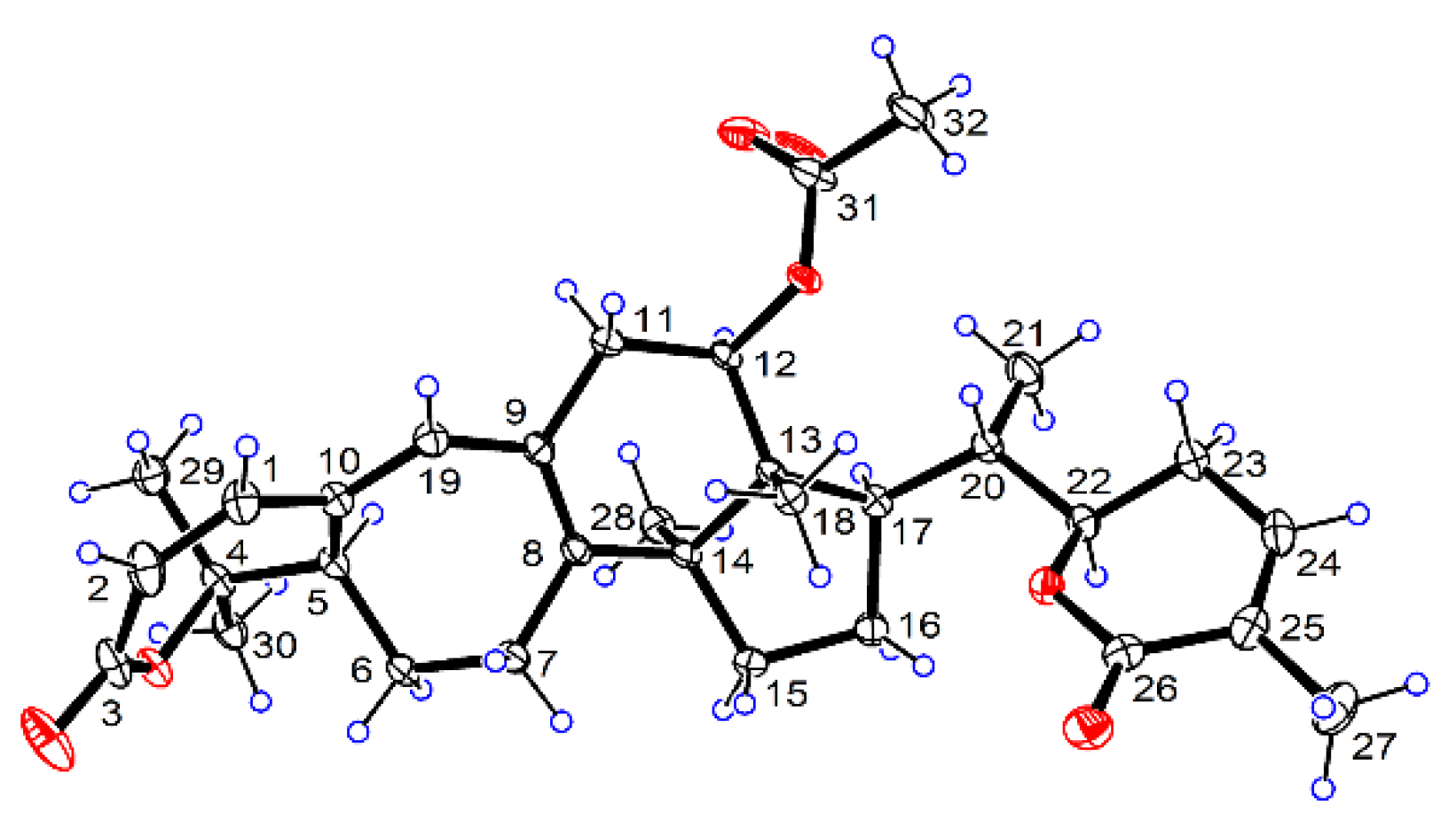
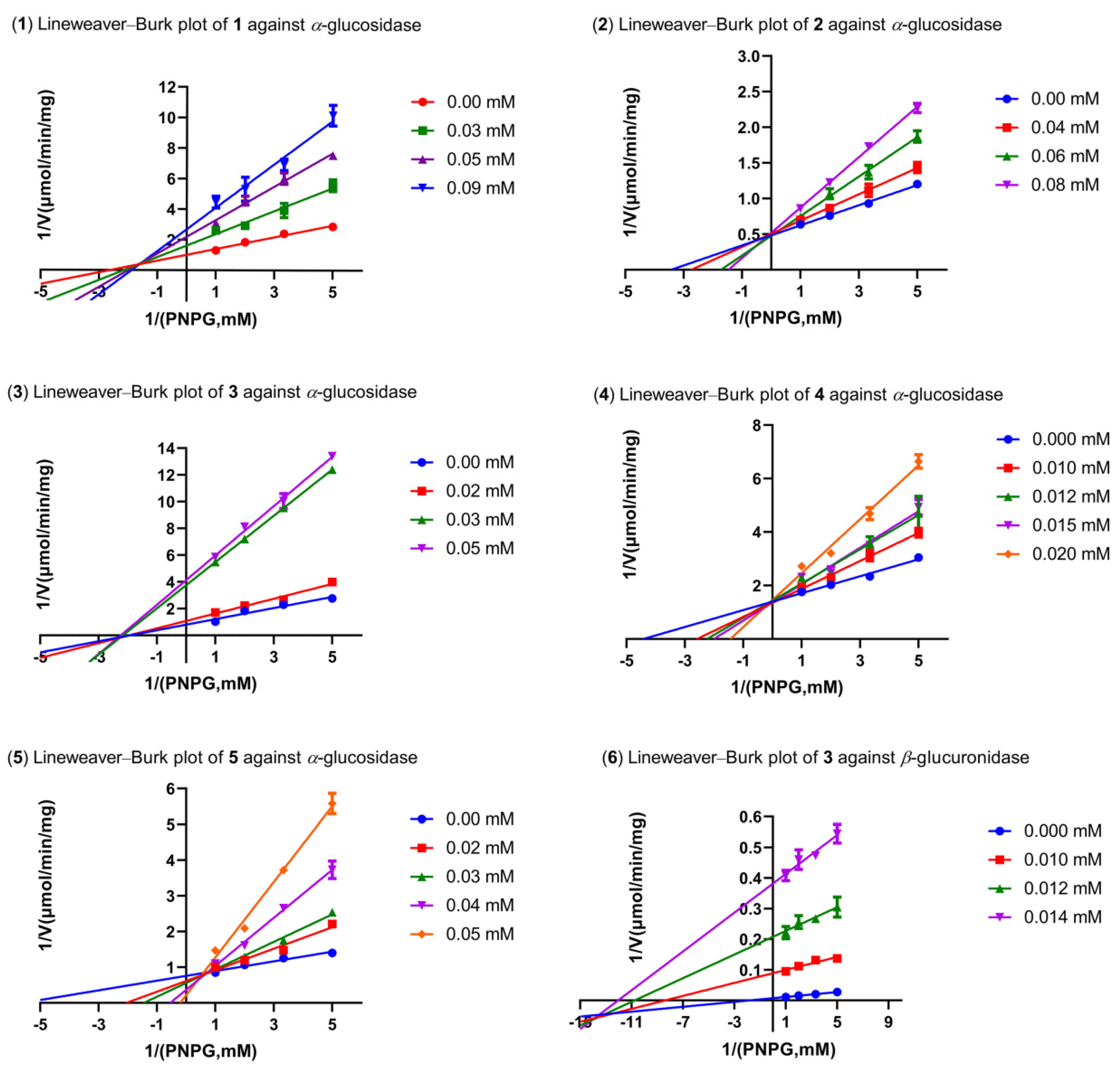
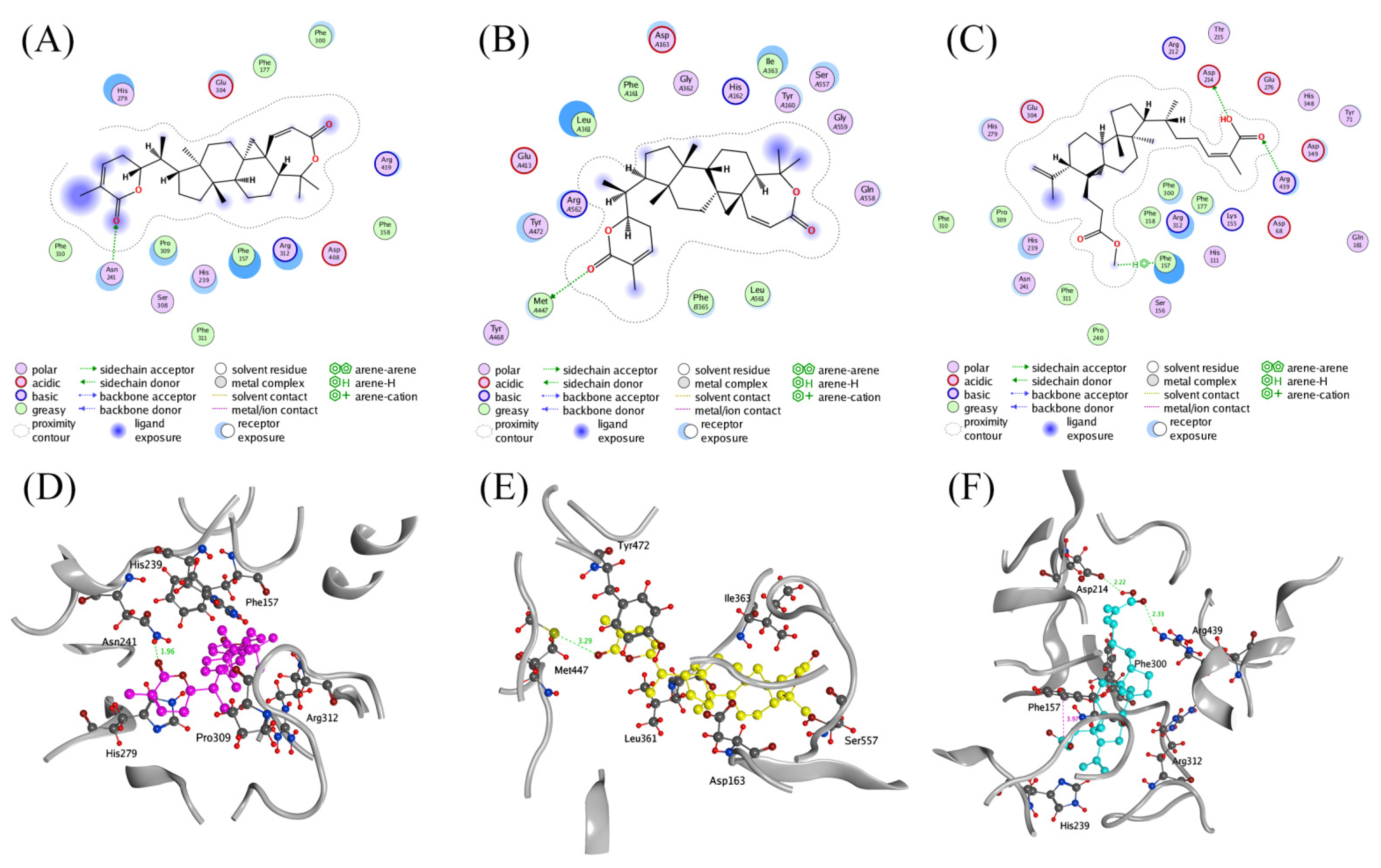
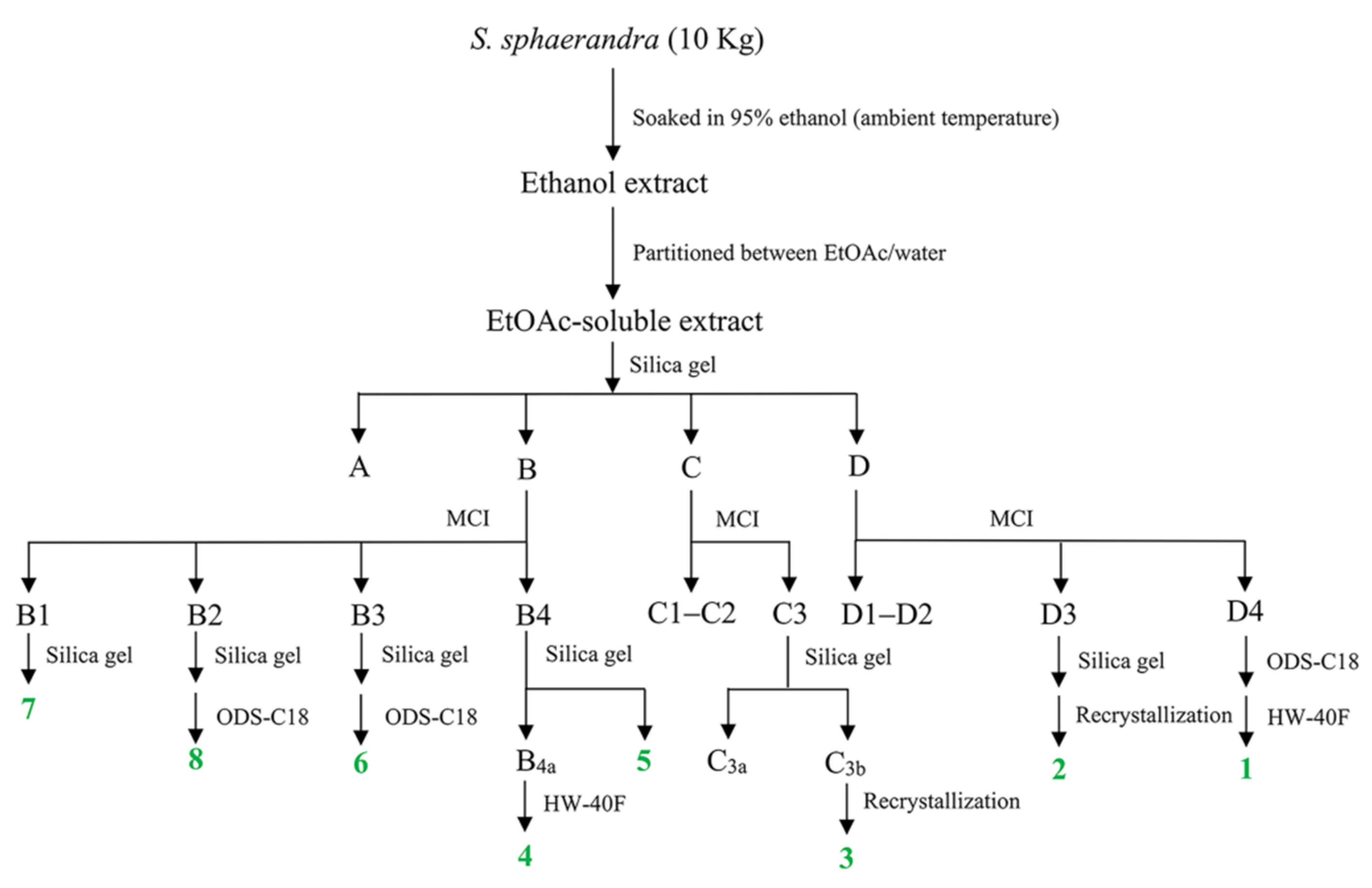
| Position | δC, Type | δH (Multi, J in Hz) |
|---|---|---|
| 1 | 143.4 | 6.65 (d, 12.3) |
| 2 | 118.5 | 5.83 (d, 12.1) |
| 3 | 167.0 | - |
| 4 | 80.4 | - |
| 5 | 49.3 | 2.46 (dd, 12.5, 5.9) |
| 6 | 39.1 | 2.37 (m) 2.24 (m) |
| 7 | 27.6 | 1.92 (m) 2.09 (m) |
| 8 | 149.5 | - |
| 9 | 128.6 Δ | - |
| 10 | 140.3 | - |
| 11 | 35.1 | 2.79 (ddd, 18.1, 7.7, 2.3) 2.00 (m) |
| 12 | 74.4 | 5.25 (dd, 7.8, 7.8) |
| 13 | 48.1 | - |
| 14 | 55.0 | - |
| 15 | 31.2 | 1.43 (m) 1.79 (m) |
| 16 | 26.8 | 1.77 (m) 1.63 (m) |
| 17 | 47.5 | 1.84 (m) |
| 18 | 11.1 | 0.87 (s) |
| 19 | 141.3 | 6.17 (s) |
| 20 | 38.4 | 2.07 (m) |
| 21 | 15.5 | 1.00 (d, 6.8) |
| 22 | 80.7 | 4.51 (dt, 12.9, 3.6) |
| 23 | 24.4 | 2.37 (m) 2.11 (m) |
| 24 | 139.4 | 6.60 (m) |
| 25 | 128.4 Δ | - |
| 26 | 166.4 | - |
| 27 | 17.0 | 1.91 (s) |
| 28 | 26.9 | 1.16 (s) |
| 29 | 26.3 | 1.53 (s) |
| 30 | 29.3 | 1.39 (s) |
| 31 | 170.9 | - |
| 32 | 21.8 | 2.06 (s) |
| Compounds | IC50 (μM) a | |
|---|---|---|
| α-Glucosidase | β-Glucuronidase | |
| 1 | 61.46 ± 1.75 | NA a |
| 2 | 74.45 ± 1.13 | NA |
| 3 | 29.49 ± 0.70 | 14.70 ± 0.10 |
| 4 | 14.08 ± 0.29 | 154.6 ± 4.68 |
| 5 | 42.94 ± 1.04 | NA |
| 6 | NA b | NA |
| 7 | NA | NA |
| 8 | NA | NA |
| acarbose | 422.3 ± 8.44 | - |
| DSL | - | 56.85 ± 1.57 |
| Compounds | Concentration (mM) | Km (mM) | Ki (μM) | Ki′ (μM) |
|---|---|---|---|---|
| 1 | 0.00 | 0.38 ± 0.06 | 35.78 | 56.99 |
| 0.03 | 0.47 ± 0.06 | |||
| 0.05 | 0.50 ± 0.09 | |||
| 0.09 | 0.53 ± 0.09 | |||
| 2 | 0.00 | 0.29 ± 0.02 | 45.15 | - |
| 0.04 | 0.36 ± 0.04 | |||
| 0.06 | 0.58 ± 0.06 | |||
| 0.08 | 0.68 ± 0.02 | |||
| 3 | 0.00 | 0.51 ± 0.06 | 10.47 | 7.93 |
| 0.02 | 0.51 ± 0.06 | |||
| 0.03 | 0.46 ± 0.01 | |||
| 0.05 | 0.44 ± 0.04 | |||
| 4 | 0.00 | 0.23 ± 0.02 | 7.97 | - |
| 0.01 | 0.38 ± 0.04 | |||
| 0.012 | 0.44 ± 0.07 | |||
| 0.015 | 0.50 ± 0.07 | |||
| 0.02 | 0.69 ± 0.08 | |||
| 5 | 0.00 | 0.18 ± 0.02 | NC a | - |
| 0.02 | 0.49 ± 0.04 | |||
| 0.03 | 0.68 ± 0.05 | |||
| 0.04 | 1.81 ± 0.19 | |||
| 0.05 | 4.73 ± 0.31 |
| Compound | Concentration (mM) | Km (mM) | Ki (μM) | Ki′ (μM) |
|---|---|---|---|---|
| 3 | 0.00 | 0.55 ± 0.04 | NC a | NC |
| 0.01 | 0.12 ± 0.03 | |||
| 0.012 | 0.09 ± 0.03 | |||
| 0.014 | 0.08 ± 0.02 |
Publisher’s Note: MDPI stays neutral with regard to jurisdictional claims in published maps and institutional affiliations. |
© 2022 by the authors. Licensee MDPI, Basel, Switzerland. This article is an open access article distributed under the terms and conditions of the Creative Commons Attribution (CC BY) license (https://creativecommons.org/licenses/by/4.0/).
Share and Cite
Rao, G.; Yu, H.; Zhang, M.; Cheng, Y.; Ran, K.; Wang, J.; Wei, B.; Li, M.; Shan, W.; Zhan, Z.; et al. α-Glucosidase and Bacterial β-Glucuronidase Inhibitors from the Stems of Schisandra sphaerandra Staph. Pharmaceuticals 2022, 15, 329. https://doi.org/10.3390/ph15030329
Rao G, Yu H, Zhang M, Cheng Y, Ran K, Wang J, Wei B, Li M, Shan W, Zhan Z, et al. α-Glucosidase and Bacterial β-Glucuronidase Inhibitors from the Stems of Schisandra sphaerandra Staph. Pharmaceuticals. 2022; 15(3):329. https://doi.org/10.3390/ph15030329
Chicago/Turabian StyleRao, Guiwei, Hangfei Yu, Manlai Zhang, Yuchen Cheng, Kun Ran, Jianwei Wang, Bin Wei, Min Li, Weiguang Shan, Zhajun Zhan, and et al. 2022. "α-Glucosidase and Bacterial β-Glucuronidase Inhibitors from the Stems of Schisandra sphaerandra Staph" Pharmaceuticals 15, no. 3: 329. https://doi.org/10.3390/ph15030329





